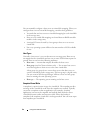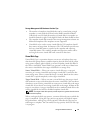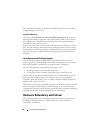
Using Your RAID Enclosure 47
Storage Management VSS Hardware Provider Tips:
• The number of snapshot virtual disks that can be created using a single
snapshot set varies with the I/O load on the RAID controller modules.
Under little or no I/O load, the number of virtual disks in a snapshot set
should be limited to eight. Under high I/O loads, the limit should be three.
• The snapshot virtual disks created in the storage management software are
differential snapshots. Plex snapshots are not supported.
• Virtual disks to be used as source virtual disks for VSS snapshots should
have names no longer than 16 characters. The VSS hardware provider uses
the base virtual disk name as a prefix for the snapshot and repository
virtual disk names. The resulting snapshot and repository names will be
too long if the source virtual disk name exceeds 16 characters.
Virtual Disk Copy
Virtual Disk Copy is a premium feature you can use to back up data, copy
data from disk groups that use smaller-capacity physical disks to disk groups
using greater capacity physical disks, or restore snapshot virtual disk data to
the source virtual disk. Virtual Disk Copy generates a full copy of data from
the source virtual disk to the target virtual disk in a storage array.
Source Virtual Disk
—
When you create a virtual disk copy, a copy pair
consisting of a source virtual disk and a target virtual disk is created on the
same storage array. When a virtual disk copy is started, data from the source
virtual disk is copied completely to the target virtual disk.
Target Virtual Disk
—
When you start a virtual disk copy, the target virtual
disk maintains a copy of the data from the source virtual disk. You can choose
whether to use an existing virtual disk or create a new virtual disk as the target
virtual disk. If you choose an existing virtual disk as the target, all data on the
target is overwritten. A target virtual disk can be a standard virtual disk or the
source virtual disk of a failed or disabled snapshot virtual disk.
NOTE: The target virtual disk capacity must be equal to or greater than the source
virtual disk capacity.
When you begin the disk copy process, you must define the rate at which the
copy is completed. Giving the copy process top priority will slightly impact
I/O performance, while giving it lowest priority will make the copy process
take longer to complete. You can modify the copy priority while the disk copy
is in progress.


















